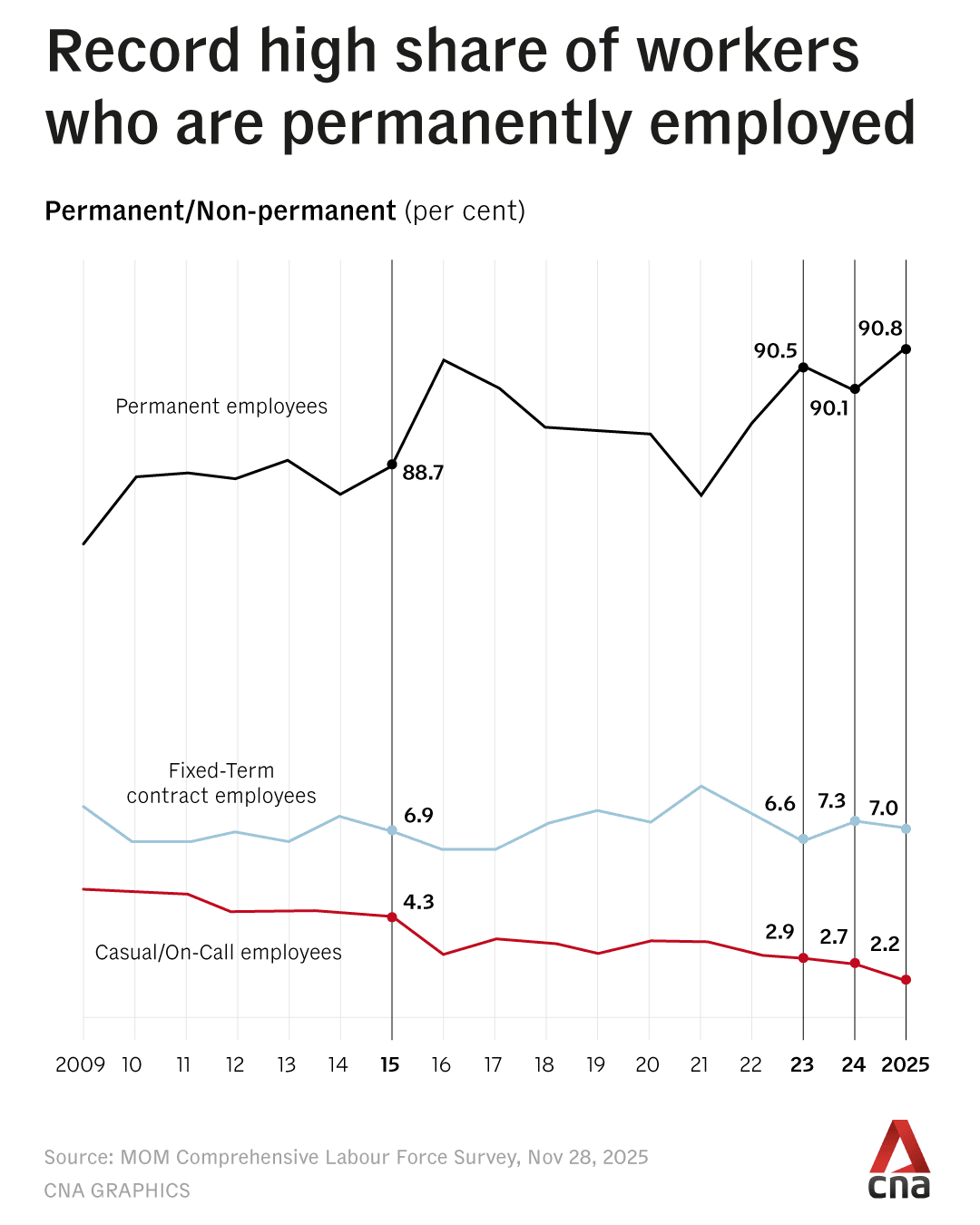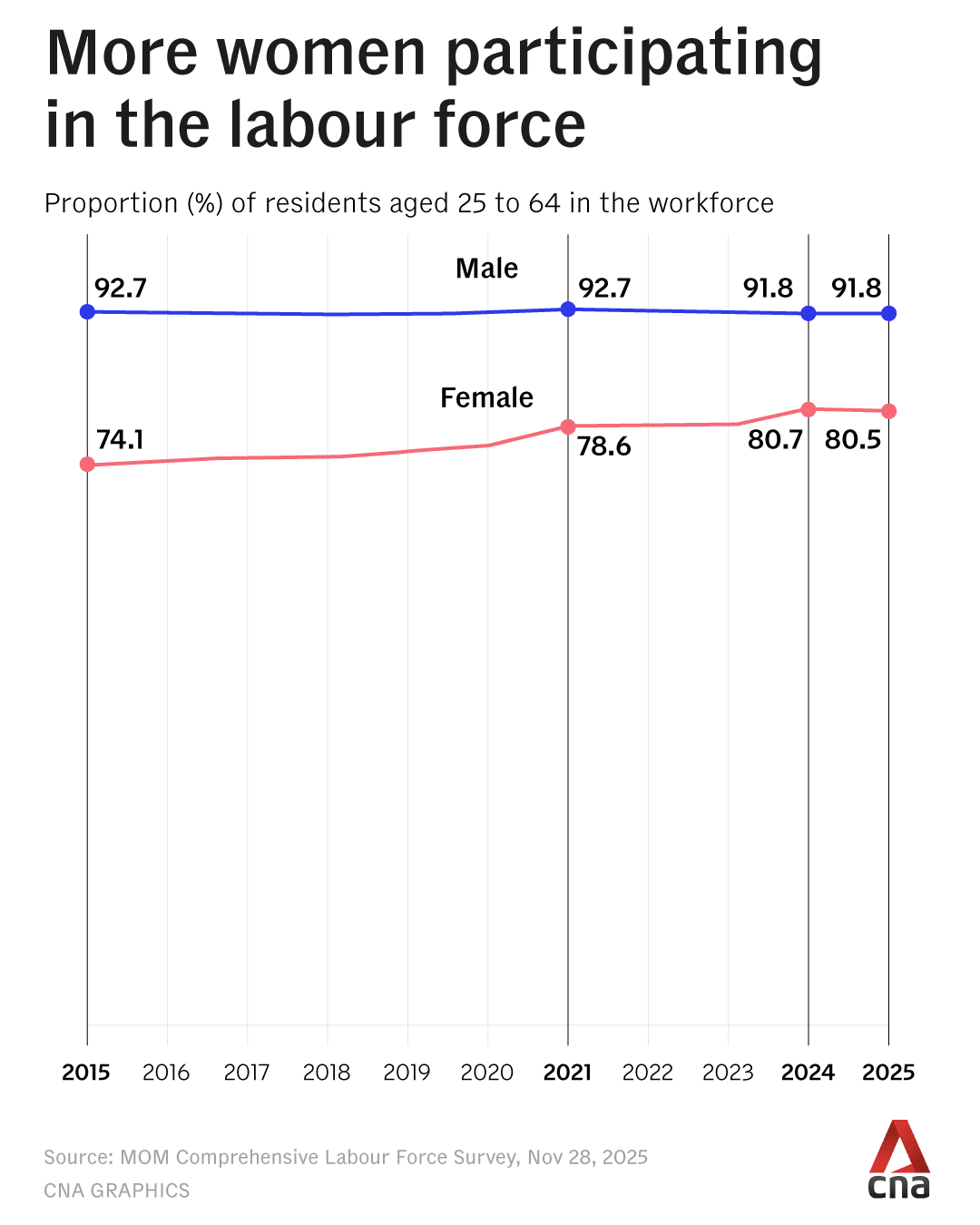Permanent employment at record high; labour force participation rate falls for 4th straight year: MOM
There appears to be no sustained shift towards shorter-term roles among younger workers, said the Ministry of Manpower.


This audio is generated by an AI tool.
SINGAPORE: The share of Singapore workers in permanent jobs hit a record high in 2025, with more workers in stable positions across almost all ages, occupations and educational levels, the Ministry of Manpower (MOM) said on Friday (Nov 28).
The proportion of workers in permanent employment reached 90.8 per cent this year, while fixed-term contracted work and casual or on-call work declined, according to an advance release of MOM's labour force report. It was 90.1 per cent in 2024, having fallen from 90.5 per cent in 2023.
The rise in permanent employment was most pronounced among youths aged 15 to 24, going up almost 8 percentage points. Those aged 25 to 29 also saw a 1 percentage point rise.
This suggests there is no sustained shift towards shorter-term roles among younger workers, MOM said.

The share of permanent employment work increased across most industries, including growth sectors like professional services, health and social services, and information and communications.
However, the proportion of residents participating in the labour force fell for a fourth straight year to 67.9 per cent, down from 68.2 per cent in 2024.
Singapore's labour force participation rate was generally on the rise from 1998, and started declining in 2022 during the COVID-19 pandemic.
MOM said the contraction is due to Singapore's ageing population, noting that the trend reflects older workers retiring and ageing out of the labour force.
The labour force comprises citizens and permanent residents aged 15 and above who are either working or looking for a job.
The participation rate is expected to continue declining until population ageing stabilises, said Mr Ang Boon Heng, director of the manpower research and statistics department.
MOM's data showed there were about 1.16 million people outside the labour force this year, 20,000 more than in 2024.
The change is primarily due to retirement, with 30.1 per cent of those not working and not looking for a job citing it as a reason.
This trend is also expected to continue as baby boomers continue to retire, the report said.
More people were also not working due to family responsibilities including housework, with 22 per cent and 15.8 per cent citing these reasons respectively.
SENIORS AND WOMEN IN LABOUR FORCE
Despite there being more retirees, the data showed that there are also more seniors aged 60 and above in the labour force, with their proportion rising from 12.3 per cent in 2015 to 19.3 per cent in 2025.
Over the same decade, the share of residents under 30 declined due to falling birth rates and because more pursued further studies, delaying their entry into the labour force.
Singapore's overall labour force participation rate still ranks highly compared with other high-income countries, the ministry said.
Demographic pressures have partly been eased by women's growing labour force participation over the past decade.

The female labour force participation rate improved significantly from 74.1 per cent in 2015 to 80.5 per cent in 2025.
This reflects the rising educational profile of women and collective efforts to support them to stay in or return to the labour force, according to MOM.
But Singapore still lags behind leading high-income countries because of women's low part-time employment rate – 5.9 per cent, compared to the average of 13.7 per cent among Organisation for Economic Co-operation and Development countries.
Mr Ang said besides higher education, other contributing factors to women's labour force participation include the change in social attitudes towards gender roles in childcare and the availability of childcare facilities.
Male labour force participation remained high at 91.8 per cent.
GROWTH IN REAL INCOMES
Real incomes at the bottom 20th percentile and the median 50th percentile both grew year-on-year, broadly in line with productivity growth over the longer term, said MOM.
Earners at the 20th-percentile saw their real incomes grow 3.8 per cent. Nominally, their earnings increased from S$3,026 in 2024 to S$3,164 this year.
Median earners gained 4.3 per cent in real incomes, with nominal earnings rising from S$5,500 in 2024 to S$5,775 this year.
The ministry said real income growth at the 20th percentile has outstripped growth at the median level over the past five-year and 10-year periods.
Over both durations, 20th-percentile earners enjoyed a 2.9 per cent increase per year in real incomes.
This was higher than the annual gain in median real incomes – 1.6 per cent per year from 2020 to 2025, and 2.1 per cent per year from 2015 to 2025.
MOM said the expansion of the Progressive Wage Model has continued to narrow the income gap between low-income and median wages.
The ratio between 20th-percentile income and median income rose to 0.55 this year, from 0.52 in 2020 and 0.51 in 2015.
Continued productivity and upgrading of skills will help to keep up support for more inclusive income growth, it added.
UNEMPLOYMENT AND DISCOURAGED WORKERS
Unemployment among both professionals, managers, executives and technicians (PMETs) and non-PMETs remained low and stable, said MOM.
The resident unemployment rate edged up from 2.7 per cent to 2.8 per cent for PMETs, and declined from 3.4 per cent to 2.8 per cent for non-PMETs.
Long-term unemployment rates eased for both groups, from 0.7 per cent to 0.6 per cent for PMETs, and from 0.6 per cent to 0.5 per cent for non-PMETs.
Separately, the proportion of discouraged workers, or those not looking for work because they feel their job search will not yield results, stayed low at 7,400 or 0.3 per cent this year.
They are mostly seniors aged 60 and over, followed by those in their 50s. MOM said this reflects "improvements in the education profile of seniors, and not because the extent of discouragement has increased among better-educated seniors".
For the first time, MOM also included data on overseas work experience by resident workers, which it will continue to collect in subsequent years.
This is part of efforts to strengthen the local workforce's readiness for corporate leadership, as multinationals commonly seek out leaders with international experience, according to the ministry.
The survey found that 76,000 or 3.1 per cent of resident workers had experience working overseas full-time for at least six months.
MOM's Comprehensive Labour Force Survey collected data from 33,000 households, with an overall response rate of 86.8 per cent.
Editor’s note: An earlier version of this article stated that the labour force participation rate started declining in 2021. It should be 2022. We apologise for the error.


















